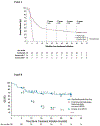Scientific and clinical developments in Merkel cell carcinoma: A polyomavirus-driven, often-lethal skin cancer
- PMID: 34836718
- PMCID: PMC8810602
- DOI: 10.1016/j.jdermsci.2021.10.004
Scientific and clinical developments in Merkel cell carcinoma: A polyomavirus-driven, often-lethal skin cancer
Abstract
Merkel cell carcinoma (MCC) is a primary neuroendocrine skin cancer that recurs in ~40% of cases. Merkel cell polyomavirus (MCPyV) and ultraviolet (UV)-induced mutations are two major causative factors of MCC. Virus-positive MCCs express polyomavirus oncoproteins that are highly immunogenic yet are required for ongoing tumor growth. Virus-negative MCCs have a high burden of UV-DNA mutations that encode tumor-specific UV-neoantigens. Thus, both UV- and virus-induced MCCs are highly immunogenic, enabling diverse T-cell targeted therapies. Optimal MCC management is challenging given its rarity, aggressive nature, rapidly evolving care guidelines, and fundamental differences in management compared to other skin cancers. MCC is often managed aggressively with extensive surgery, radiotherapy or systemic therapy, frequently leading to toxicities that might have been avoidable while still achieving optimal disease control. Thus, multi-disciplinary care is crucial for providing patients with the best possible outcomes. The outlook for many patients with advanced MCC has progressed remarkably over the past decade due to PD-1 pathway blocking agents that provide durable benefit for a substantial subset of MCC patients. The management of early-stage MCC has also improved due to better approaches to integrate surgery and radiotherapy. Prognostic accuracy and ongoing surveillance have advanced due to stage-specific recurrence data and sophisticated "liquid biopsies" that allow early detection of disease recurrence. Here we summarize both recent striking progress and pressing challenges such as PD-(L)1-refractory MCC, and management of MCC patients with immune dysfunction. We also highlight diverse resources to allow providers to take advantage of recent progress in this fast-moving field.
Keywords: Cutaneous neuroendocrine carcinoma; Immunotherapy; Merkel cell carcinoma; Merkel cell polyomavirus; Multidisciplinary care.
Copyright © 2021 Japanese Society for Investigative Dermatology. Published by Elsevier B.V. All rights reserved.
Figures



Similar articles
-
Multidisciplinary Treatment, Including Locoregional Chemotherapy, for Merkel-Polyomavirus-Positive Merkel Cell Carcinomas: Perspectives for Patients Exhibiting Oncogenic Alternative Δ exon 6-7 TrkAIII Splicing of Neurotrophin Receptor Tropomyosin-Related Kinase A.Int J Mol Sci. 2020 Nov 3;21(21):8222. doi: 10.3390/ijms21218222. Int J Mol Sci. 2020. PMID: 33153070 Free PMC article.
-
Merkel Cell Carcinoma in the Age of Immunotherapy: Facts and Hopes.Clin Cancer Res. 2018 May 1;24(9):2035-2043. doi: 10.1158/1078-0432.CCR-17-0439. Epub 2017 Dec 7. Clin Cancer Res. 2018. PMID: 29217527 Free PMC article. Review.
-
Merkel cell polyomavirus-specific immune responses in patients with Merkel cell carcinoma receiving anti-PD-1 therapy.J Immunother Cancer. 2018 Nov 27;6(1):131. doi: 10.1186/s40425-018-0450-7. J Immunother Cancer. 2018. PMID: 30482247 Free PMC article.
-
Rationale for immune-based therapies in Merkel polyomavirus-positive and -negative Merkel cell carcinomas.Immunotherapy. 2016 Jul;8(8):907-21. doi: 10.2217/imt-2016-0009. Immunotherapy. 2016. PMID: 27381685 Free PMC article. Review.
-
Advances in Immunotherapy for Metastatic Merkel Cell Carcinoma: A Clinician's Guide.J Natl Compr Canc Netw. 2018 Jun;16(6):782-790. doi: 10.6004/jnccn.2018.7049. J Natl Compr Canc Netw. 2018. PMID: 29891528 Review.
Cited by
-
Merkel cell carcinoma refractory to anti-PD(L)1: utility of adding ipilimumab for salvage therapy.J Immunother Cancer. 2024 Jul 24;12(7):e009396. doi: 10.1136/jitc-2024-009396. J Immunother Cancer. 2024. PMID: 39053946 Free PMC article. Review.
-
[Human polyomavirus-associated skin diseases].Hautarzt. 2022 Jun;73(6):426-433. doi: 10.1007/s00105-022-04993-8. Epub 2022 Apr 28. Hautarzt. 2022. PMID: 35482045 Review. German.
-
Skin Photoaging and the Biological Mechanism of the Protective Effects of Hesperidin and Derived Molecules.Antioxidants (Basel). 2025 Jun 26;14(7):788. doi: 10.3390/antiox14070788. Antioxidants (Basel). 2025. PMID: 40722892 Free PMC article. Review.
-
Merkel Cell Carcinoma Display PIEZO2 Immunoreactivity.J Pers Med. 2022 May 28;12(6):894. doi: 10.3390/jpm12060894. J Pers Med. 2022. PMID: 35743679 Free PMC article.
-
The Evolving Treatment Landscape of Merkel Cell Carcinoma.Curr Treat Options Oncol. 2023 Sep;24(9):1231-1258. doi: 10.1007/s11864-023-01118-8. Epub 2023 Jul 5. Curr Treat Options Oncol. 2023. PMID: 37403007 Free PMC article. Review.
References
Publication types
MeSH terms
Substances
Grants and funding
LinkOut - more resources
Full Text Sources
Medical
Miscellaneous

